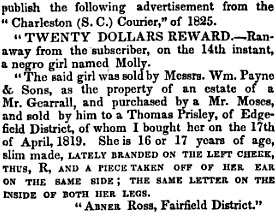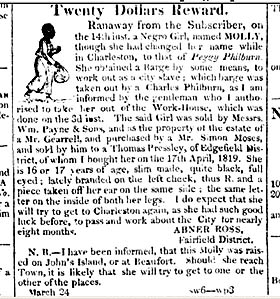Southern evidence about the punishment of slaves
 Reading the newspaper, daguerreotype circa 1845-48. Source.
Reading the newspaper, daguerreotype circa 1845-48. Source.
August 17, 2015
By Toussaint HeywoodSome people have argued that slavery wasn't so bad. Today they may be in the grip of Lost Causism and picture the antebellum south as a place of workers taken care of for life as they sang in the cottonfields. In the antebellum period, there were also skeptical northerners whom abolitionists needed to convince.
Such people point out that much of the evidence for the worst slave tortures comes from biased sources: escaped slaves, anti-slavery northerners or foreigners who visited the south, or former southerners who turned against slavery and moved north.
It's true that statements in anti-slavery publications like Slavery As It Is, The Liberator, or slave narratives or travel accounts make for quick and easy research. If an unusual punishment comes from several different sources, one can generally conclude it was used--unless the sources were all copying one another.
But we are not limited to northern anti-slavery sources. Southern, pro-slavery sources abound, and generally corroborate the northern evidence. Let's take a look at a couple of such sources.
Newspapers
Runaway ads in southern newspapers were easily available to northern subscribers, and abolitionists gleefully pounced on ones recording mistreatment. Research today shows that, on average, the ads were genuine with a few unimportant changes in wording or perhaps an incorrect date.
 Ad from Slavery As It Is.
Ad from Slavery As It Is.
I can't find the ad in the few dates of the Charleston Courier from the 1820s that are available, but slave-owners often ran the same ad in several papers, and the correct ad seems to show up in the Charleston City Gazette, reproduced from the actual newspaper below. The date is off by quite a few years, 1821 rather than 1825. The whole ad is much longer with details uninteresting to anti-slavery advocates.
 Ad from March 24, 1821 Charleston City Gazette.
Ad from March 24, 1821 Charleston City Gazette.
One can search for ads at the Chronicling of America site. For example, a search for "iron" near "reward" showed the ad below, one of three placed in the Piney Woods Planter and Amite Union Literary Reflector, April 07, 1838, by Philip R. James of Amite County, Mississippi. The other two people had iron riveted on their legs, while John "has old marks of the whip on his buttocks and thighs."
The antebellum New Orleans Bee is online, though not searchable, at New Orleans Bee.
But perhaps the quickest way of finding southern ads detailing marks of punishment or iron appliances is to look at the examples already collected by abolitionists, such as throughout Slavery As It Is, with the caveat that most ads are genuine but must be double-checked for minor discrepancies.
Lawsuits
Another source for southern description of slave treatment, or mistreatment, is in southern court records. These often have detailed descriptions of some of the worst treatment, and one can also read the court's reaction to it. State supreme court cases are easy to find online:
In Virginia, a man was found guilty of second degree manslaughter for killing his own slave, Sam, "with cruel and excessive whipping and torture, inflicted by [the owner], aided by two of his other slaves."
In South Carolina, a slave was "whipped severely with twenty stripes" by a patroller before 9 p.m. After that time "the Act authorizes the patrol to take up and whip slaves, found outside of their owner's premises without a pass."
In Louisiana, a defendant owned a woman, Caroline, who was "addicted to robbery; being in the habit of running away, and attacked with a convulsive disorder, incurable in its nature, during which she is every time near the grave"--the latter probably epilepsy. He claimed this lessened her value, and told how he "brought Caroline to [a witness's] house with an iron collar and her hands tied, and told the deponent she had stolen some handsome dresses."
Legislative petitions are also online at the Race and Slavery Petitions Project. For example, in 1858 South Carolina, "William Boyd seeks compensation for an injury he sustained while attempting to overtake three runaway slaves.... With the aid of dogs, they chased the slaves ten miles. When they finally caught up with the fugitives, a desperate struggle ensued, and Boyd was struck by a rock on his right arm. The runaways were finally subdued by a force of about forty-five or fifty men."
Local criminal court reports are less often online but can be found at state archives.

